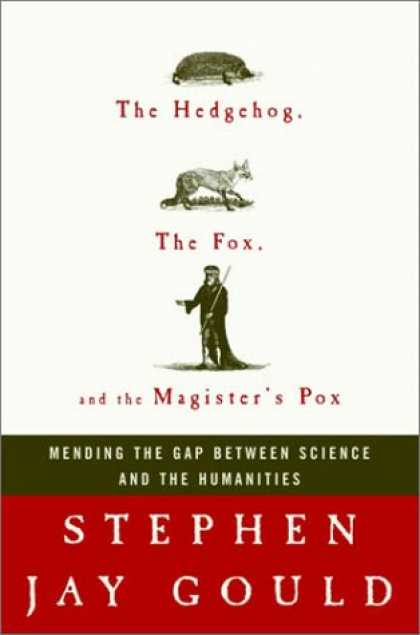
|
There are two kinds of inquisitive minds, Hedgehogs and Foxes. In nature, Foxes rely on a wide range of crafty strategies to avoid prey. Hedgehogs rely on one tried and true defense, rolling up into a ball and baring their quills. Intellectually, Foxes dart from topic to topic, surveying a wide range of ideas across a broad spectrum of research fields. Bill Nye, Science Guy and other science popularizers are good examples of the fox scientist. Hedgehogs hunker down into one topic and research thoroughly. Your typical graduate student working on their thesis is a hedgehog.
Paleontologist, evolutionary biologist, and historian of science, Stephen J. Gould opens his book on the artificial dichotomy we place between science and the humanities with this remarkably humanistic metaphor. It’s credited to the poet Archilochus, who said, “The fox knows many things, but the hedgehog knows one big thing.” I think it would be fair to say the metaphor pervades scientific discourse, as I see it being used in many blogs and essays in my science reading.
So Gould has opened his text with a clear example of Science and Humanities in marriage, Science providing two ways of knowing and the humanities providing two anthropomorphic animals to associate with them. What better way to start a dialogue on why no dichotomy splits science and humanities?
Unfortunately, this borrowed metaphor is where the text’s accessibility ends. Despite his calls for “user friendly” science and criticisms of scientists for being insular, Gould’s own writing is extremely erudite. Even with my humanities background (English BA), I found Gould difficult to read in places. Some of his jokes are very intellectually nuanced, so that I often had to reread passages to confirm that I had forgotten to laugh.
At the same time, Gould is the perfect science writer to tackle this topic intellectually. He aptly matches wits with Critical Theorists. He is well-versed with literary criticisms of science, especially post-modernist critical theory, which has assaulted the scientific method of knowing as being just as susceptible to cultural bias as any other form of knowledge:
Science must no longer give the impression it represents a faithful reflection of reality. What it is, rather, is a cultural system, and it exhibits to us an alienated interest-determined image of reality specific to a definite time and place (Wolf Lepenies quoted (Gould,98)).
Stephen J. Gould totally dresses Lepenies up in pigtails and bends the PoMo over his knee (metaphorically speaking), when he answers:
How could scientists ever muster the energy and stamina to clean cages, run gels, calibrate instruments, and replicate experiments, if they did not believe that such exhausting, exacting, mindless, and repetitious activities could reveal truthful information about a real world? If all science arises as pure social construction, one might well reside in an armchair and think great thoughts (Gould, 103).
Gould seasons his book with photographs of the old texts he references. Like an archeologist, he must go to the primary source, see the notes written in the margins, witness the Catholic imprimatur approving the publication of naturalist writings deemed inoffensive to the church, and the painstaking post-hoc censorship of Konrad Gesner’s name from his Historia animalium, not because he wrote anything offensive in that book, but because he had offended the church in general. Gould comments on his love for original texts:
I… conceived the admittedly quirky and idiosyncratic idea for this book–to base a volume on the well-trodden subject of science and humanities upon largely unknown examples taken from specific passages in anti-quarian books from my own collection–a classical technique of humanist scholars, but now attempted by this card-carrying scientist!
Gould has some criticisms for the humanities himself. He questions the concept in humanistic writing that written words should mimic the spoken. Spoken words require repetition to reinforce concepts because of the medium’s ephemeral nature. I was glad to see one of my pet peeves in college voiced by someone deserving some respect. Written words that mimic the spoken tend toward redundancy and repetition.
Although he takes pains to defend science against humanistic criticisms, Gould also lays into scientists themselves. He calls for, “breaking down of artificial barriers between the sciences and the humanities,” by applying “‘user friendly’ themes in humanistic study…” (Gould, 138). In less challenging words, scientists should look at how artsy people communicate and persuade the public and apply the same rhetorical techniques.
Science gets so third person that it gets ridiculous, but this is because science depends on objectivity. It must disassociate the observed facts from the observer. This tends to make science writing dry and unengaging. By putting the human element into the writing, science writers can bring a wider audience into their fold.
“The Hedgehog, the Fox, and the Magister’s Pox: Mending the Gap Between Science and the Humanities” Stephen J. Gould, Harmony Books 2003.
Additional Notes:
- This is Part I of my evaluation of Gould’s book, which was too dense for me read in one sitting, and it may leave readers wondering about the third thinker Gould has added to the metaphor I mentioned in the beginning, the Magister’s Pox. He is only mentioned briefly in the book’s first half as the censor, the figure who prohibits knowledge altogether.
- A fascinating development in the realm of critical theory is worth reading about; although, it doesn’t seem a fascinating subject to actually read is Literary Darwinism, which does blend science and the humanities, but I doubt it will appeal to either scientists or literature buffs.